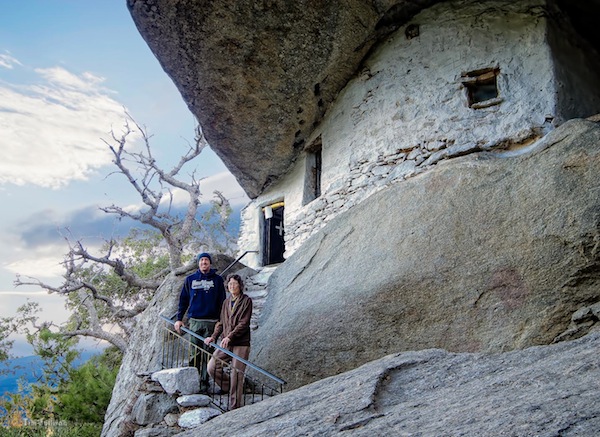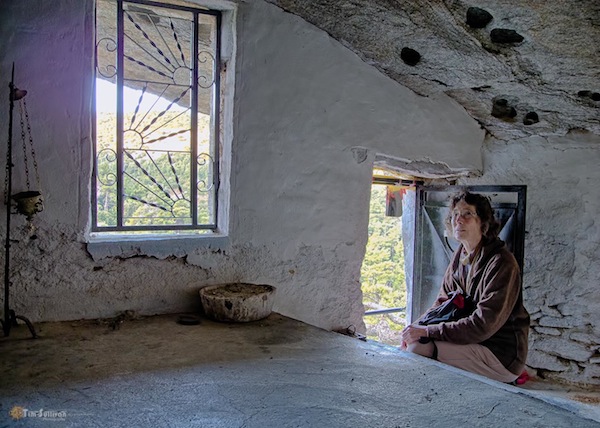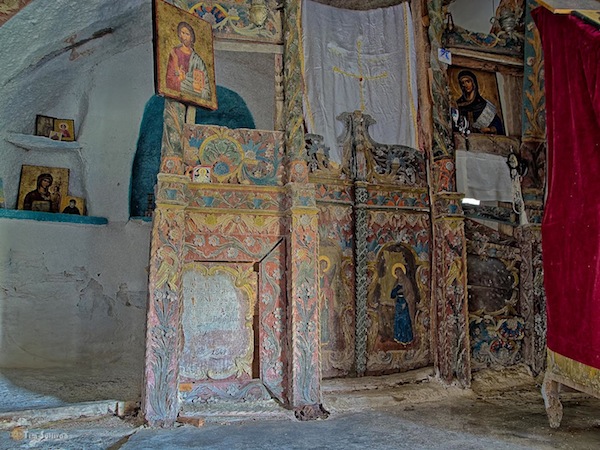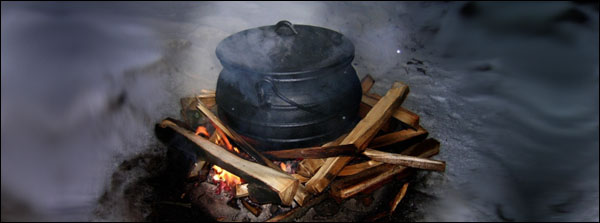The Witch, the Chapel, and Mountain Tea: How a Trip Turns into a Story
“Summing up an experience while it’s happening instead of waiting a decent interval for it to settle out, has become normal practice. Which is really weird, if you ask me. It’s as though we’ve finally agreed that what we say about something trumps what we actually know about it.” Anita Sullivan
The Highest Cauldron
By Anita Sullivan

 EUGENE Oregon—(WeeklyHubris)—12/24/2012—My son Tim and I took a trip to Greece and started telling people about it before it was over. Isn’t that so typical these days?
EUGENE Oregon—(WeeklyHubris)—12/24/2012—My son Tim and I took a trip to Greece and started telling people about it before it was over. Isn’t that so typical these days?
Even before you get off the airplane, you’ve already emailed a variety of short summaries from your computer in a hotel, along with some pictures. Summing up an experience while it’s happeninginstead of waiting a decent interval for it to settle out, has become normal practice. Which is really weird, if you ask me. It’s as though we’ve finally agreed that what we say about something trumps what we actually know about it.
When you first arrive home after a really important trip, you could open your mouth and say anything. You could talk for days: whole gangs of impressions and feelings are roaming around inside of you, as yet unorganized. But everybody, including yourself, expects you to present your trip as a story—which can mean radical re-organization of what your body, mind and heart are telling you, in their own wordless language.
There are two common ways to start shaping your raw trip experiences into a fully work-hardened narrative: 1) You can immediately chop the journey up into manageable parts, based on chronology maybe, or upon the most key dramatic events; 2) You can stick with a general overview, hitting the highlights and giving the impression that the whole thing was destined from the start to be a dramatic tale, never an open-ended, raw life experience with the constant possibility of disintegrating into meaningless or miserable chaos.
However you begin telling about your trip, you naturally want it to sound entertaining and dramatic, so you emphasize certain events, maybe exaggerate a little until, pretty soon, your cache of idiosyncratic experiences start to get their edges rubbed off, and gradually succumb to the demands of the “universal story grid” that families have been telling around kitchen tables for generations—for centuries.
This can be good and bad. It’s probably inevitable. But I wonder if there’s a way to keep the story fresh, by telling . . . a different story each time. Not because you’re starting to steal parts from other stories similar to your own, but because you are actually able to keep remembering.
Here’s a segment of our trip that didn’t get into The Big Story:
It’s a Saturday morning on Ikaria, another gorgeous sunny, mild day in mid-October. Our plan for today is to hike some of the island’s famous monopatia, the old footpaths through the mountains that used to keep villages in touch with each other, before roads and automobiles. There was really no such thing as an “isolated village,” because people were always moving along the trails from one to the other. (Our third day in Greece, and we were already falling prey to the “tourist angst” that comes when you only have a short time to knock out that list of neat stuff you want to be able to boast about when you get home.)
But Tim, my son, isn’t feeling so well this morning. He sits up in his bed with his stocking cap on, his computer on his knees, and that faraway look in his eye. This young man is in no way ready to take off on a hike any time soon. With a sigh, I pick up a book and go sit on the flagstone balcony overlooking the sea. Within five minutes, I’m driven indoors by wasps. I guess I can cross off “relaxing at the picturesque high-mountain villa.”
After that, two things happen. The landlady appears alongside the window with her hose, watering the garden, and inquires how we’re doing. Within five minutes, she has gone upstairs and made up a thermos of the famous Ikarian tsaitouvounou, or “mountain tea.” It’s a tea the islanders concoct from fresh herbs, and sip throughout the day (during those hours when they’re not drinking wine). They use different herbs, depending on the season and their whim, and their particular health needs. In this case, our landlady brings us a tea that would help overcome the sluggishness of jet lag and general trip fatigue. Within ten minutes Tim feels well enough to pick up his bed and walk.
The second thing that happens is that we climb over the anti-goat fence surrounding the property because we don’t have sense enough to notice that the gate isn’t locked, and start up the road to one of the official local tourist attractions. This will be a sort of mini-hike, before we actually start out up a real mountain trail a little later in the day. After lunch, maybe.
The next part of this story usually appears in the narrative as “The Visit to The Monastery,” and it’s all about the tiny whitewashed chapel that long ago was bricked into the gap between two enormous boulders. I wanted my son to see this example of traditional Ikarian architecture, because it really is amazing and charming, and because the chapel is so small it seems made for children instead of grownups; only about five people could ever possibly fit inside at one time, including the priest. Climbing up to its tiny door reminds me of my childhood tree-house, and that irresistible urge to build a secret hideaway up off the ground.

But the part that usually gets left out of the tale is walking back down the steep narrow path to the main church (everything in this part of the island is steep), and pausing at the edge of a small precipice to look down at a little terrace below. There we could see a tall person in jeans, boots, and a kind of cowboy hat standing beside a pile of apples with a bucket in his hand. The apples looked as if they had fallen from the nearby tree, and had been carefully raked into this nice pile, just so somebody could comfortably gather them. The figure turned around, looked up and caught sight of us. “What are you doing out here so early?” he called out cheerfully in Greek, and we discovered it was a woman. “Wait just a minute!” she said. I looked at my son in some dismay.
This was the Caretaker. We had passed her pristine little house on our way up to the chapel, passed her immaculate flower garden, her tomatoes and, in typical island fashion, we had brazenly walked through and found our own way between the church buildings up the hill to the chapel in the back. Now she would come up and perform her witchly duties. “Loukoumades!” she would say in a low voice, and we would find ourselves helplessly drifting over to sit at a little wooden table to drink coffee and eat mounds of sweet bread covered with sugar and syrup.
After eating and drinking our fill, we would be allowed to waddle off, having first made a donation to show our delight and gratitude, and doubtless to contribute to her livelihood. All very fair, to be sure. But if there’s one thing my aging body refuses to tolerate any more, it’s white bread and sugar. Tim and I agreed we would politely refuse this favorite traditional island snack, hoping we could escape without being turned into something bovine or piscine.
But we didn’t have to be rude or stealthy after all. Maybe it was too early, or she was too busy, but this large brisk lady made only a perfunctory attempt to ensnare us— “Coffee?” she said sweetly, and we both smiled and shook our heads. Then she unlocked the main church for us and strode cheerfully off to her other duties.

While Tim took a couple of photos of the faded and mysterious set of frescoes on the inner walls, I went outside to the wrought iron fence that bounds the plaza in front of the church. I first came here almost 20 years ago, just at sunset, and stood with a group of other students for about half an hour in complete silence as we watched the enormous orange sun wheeling itself into the sea, and listened our way into the sudden darkness that followed. At the time, and now once again, that seemed the most holy act I could imagine anyone committing in such a place.
The ability not just to remember, but to re-enact a portion of this previous event, lent me a strange cross-eyed sense of hope and despair, both of them very active and not cancelling one another out but building to a wild energy. Just the thing I needed for a walk up the mountain path, past wild goats and beehives and enormous snuffling pigs, later in the day.
![]()
Photos by Tim and Anita Sullivan.

4 Comments
diana
Love the descriptions of what happens and what doesn’t as well as the photos. Though I would never think of loukoumades as white bread dripping with honey — I always call them doughnut holes. But thinking back to coming back from trips when I was still living in Long Island, I was never even given a chance to tell my stories. People would invariably say, ‘did you have a nice trip? How was the flight?’ and then move back to their own to me very boring conversations. Maybe that was why I left.
Linda Makris
Having never visited Ikaria, I enjoyed your story. One comment about “mountain tea” – I believe it is made from just one herbaceous plant which grows all over many Aegean islands. It seems to be related and indeed resembles wild sage. I don’t know what it is called in English nor do I know the botantical name. I can’t find it in any books on herbs. I do know that the Greeks swear by its famed efficacious properties. When we go to Karystos, Evia, my husband brews to pungent-smelling stuff by the potfuls (and even in Athens). So, if anyone knows what this plant is, pls let us know. There is another one they called “hamorigani” or low oregano. It doesn’t look like any oregano or marjoram I’ve seen, but is perhaps related as well. Another one that has escaped the regular botanical guides. Look forward to more articles on your trips. Linda M.
Anita Sullivan
Thanks, Linda, this is intriguing. Herbs are a little like gods and goddesses, they don’t transfer exactly from one culture to another! In Western Oregon we probably can’t grow the herbs for Ikarian mountain tea, but we can do our own version of it. I confess I did some experimenting with chamomile, mint and rosemary before the first frost killed off the first two. But it wasn’t the same, alas.
eboleman-herring
Anita and Linda: http://greekfood.about.com/od/mezethesdrinks/a/tsaitouvounou.htm